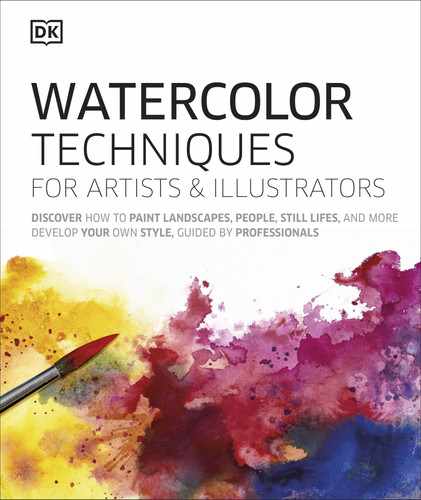
114 Intermediate | TECHNIQUES
PUTTING IT INTO PRACTICE
In this painting, the negative spaces help dene the
character of the classical architecture and its features.
The spaces around and between the solid objects are all
negatives that bring a sense of depth to the composition.
Negative spaces
DEFINING THE SHAPES IN BETWEEN
The areas that create voids inside a
subject, or around the outside of a shape or
“positive” form, are called negative spaces.
In a landscape this could be the sky behind
a wood, or the gaps between the trees.
By following the shape of the negative,
sometimes seen as a silhouette, you will
dene the shape of the positive form.
Looking for the negative
Negative spaces can be dark or light. To nd a negative,
concentrate on observing the space around or in
between solid objects. Observe differences in tone to
dene either a light solid against a dark space, or dark
solids in a light space. For some subjects, try viewing
your subject as a silhouette to help nd the solid form.
2
Paint silhouettes
First, apply the pale color of the building
and foreground, with a few touches of
cerulean blue wet-in-wet. Next, paint the
sky around the silhouette of the buildings.
1
Preliminary drawing
The strong shadows in this location
sketch help articulate the architecture
and can be used as a guide for dening
the negative shapes. Plot outlines of the
building to organize the proportions.
The light sky behind
the buildings creates
a silhouetted skyline
Tonal differences
It can be useful to see the
negative spaces in and around
an object as an aid to drawing
a complicated shape. Here, the
dark spaces in between the
fence posts recede, which
brings the light fence forward
and claries the solid structure.
Silhouetted shapes
Look at the shapes around an
object or in the voids between
shapes. These can be found
in skies in landscapes or the
backdrops to a still life or gure
study, where the empty space
creates a silhouette that denes
the solid form.
US_114-115_Negative_space.indd 114 02/04/2020 3:34pm

115 Negative spaces
Town Hall, Liverpool
3
Dene shadowed spaces
Use a cool blue to add the main
shadows between the columns, the
spaces between the balustrades,
and the ones inside the arches.
These negative spaces will clarify
the structure of the building.
4
Structural details
There can be more than
one layer of negative space; the
windows between the columns
are also negatives. Add the darker
details within the architecture with
a no. 3 brush to ensure the shapes
are not ooded.
No. 10 and no. 3 soft-hair
round brushes
20 x 22
1
/2 in (50 x 56 cm)
cold press 300 lb (425 gsm)
watercolor paper
You will need
Yellow ocher
Burnt sienna
Cobalt blue
Cadmium
orange
French
ultramarine
Opera rose
Ultramarine
violet
Light red
Raw umber
Cerulean blue
Neutral tint
Phthalo blue
Indigo
Cobalt violet
US_114-115_Negative_space.indd 115 02/04/2020 3:34pm
..................Content has been hidden....................
You can't read the all page of ebook, please click here login for view all page.
